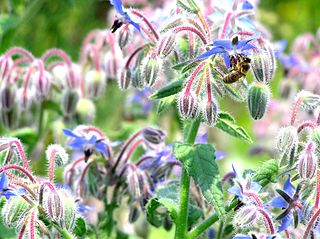Related Research Articles

Boraginaceae, the borage or forget-me-notfamily, includes about 2,000 species of shrubs, trees and herbs in 146, to 156 genera with a worldwide distribution.

Cynoglossum is a genus of small-flowered plants in the family Boraginaceae.

Boraginoideae is a subfamily of the flowering plant family Boraginaceae s.s, with about 42 genera. That family is defined in a much broader sense in the Angiosperm Phylogeny Group (APG) system of classification for flowering plants. The APG has not specified any subfamilial structure within Boraginaceae s.l.

Lobostemon is a genus of flowering plants belonging to the family Boraginaceae. Its native range is South Africa. The majority of species are limited to the winter rainfall area of the country, from Springbok to Mossel Bay. In Afrikaans these species are known as agtdaegeneesbos, or loosely translated, bush that will heal in eight days. As this name suggests, many species have medicinal properties. This is best known from Lobostemon fruticosus, which is used for treating wounds, blood poisoning, ringworm, skin diseases and syphilis.
References
- ↑ APG (2016). "An update of the Angiosperm Phylogeny Group classification for the orders and families of flowering plants: APG IV". Botanical Journal of the Linnean Society . 181 (1): 1–20. doi: 10.1111/boj.12385 .
- ↑ Doyle, J. A.; Donoghue, M. J. (1986). "Seed plant phylogeny and the origin of the angiosperms - an experimental cladistic approach". Botanical Review. 52 (4): 321–431. doi:10.1007/bf02861082.
- ↑ Butler, Rhett A. (1 July 2019). "Total number of plant species by country". Mongabay. Retrieved 21 July 2019.
- ↑ "Vegetation of South Africa". PlantZAfrica.com. SA National Biodiversity Institute. Retrieved 24 July 2019.
- 1 2 3 4 5 6 7 8 9 10 11 12 13 14 15 16 17 18 19 20 21 22 23 "species_checklist_20180710.csv". South African National Biodiversity Institute. Retrieved 27 September 2020.